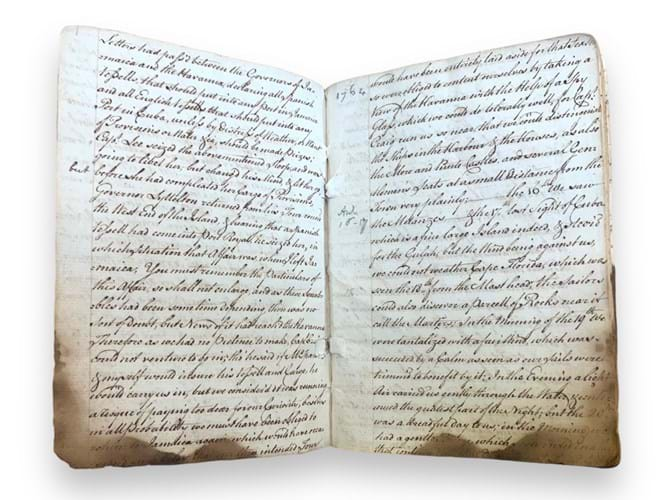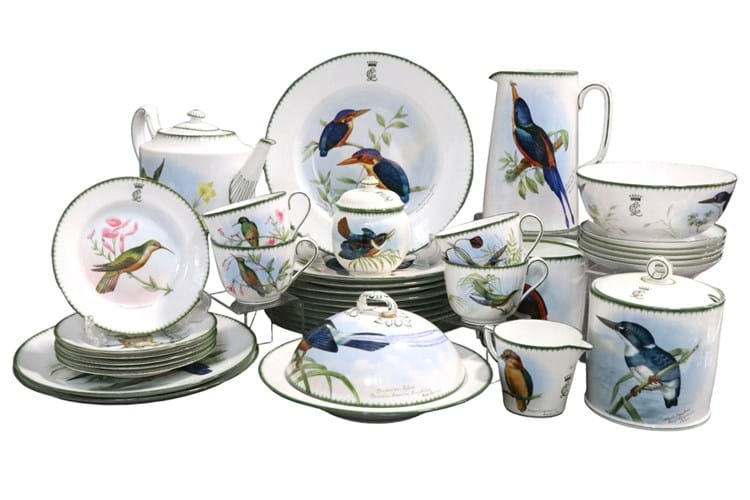1. Copeland dinner service – £6800
There were many massive English country house sales in the 20th century but the largest by volume was the contents sale at Lowther Castle during April, May and June 1947. Many items from the dispersal, conducted for Lancelot, 6th Earl Lonsdale (1867-1953), found their way across the globe but some stayed closer to home.
Included in the sale at Laidlaw in Carlisle on November 30 was an early 20th century hand painted ornithological dinner service by Copeland. Each piece was individually decorated with a bird annotated with its Latin and common names and place of origin and marked to the base for the London retailer Daniel of Wigmore Street.
The addition of the Lonsdale cipher beneath a coronet marks it as one of the many extravagant purchases of Hugh Cecil Lowther, 5th Earl of Lonsdale (1857-1944). Known as the Yellow Earl for his penchant for the colour (as first president of the Automobile Association he suggested their famous livery), it was his free spending that wrecked the vast Lonsdale estate. His brother was forced to conduct the fire sale shortly after the Second World War.
The Copeland service, showing the Staffordshire factory at the top of its game c.1910, included some damaged pieces but, estimated at £1000-2000, took £6800.
2. German silver beaker – £24,000

A late 16th century German silver and ‘lemon’ parcel-gilt ‘monatsbecher’ (month beaker) by Hans Erne of Strasbourg, £24,000 at Noonans.
The small German silver and parcel gilt beakers known as ‘monatsbecher’ (month cups) were made in sets of 12, one for each month of the year. Used almost exclusively in German-speaking countries, they were fashionable between the early 16th and mid 17th century.
Many borrowed the allegorical designs of Virgil Solis (1516-1564), one of Nuremberg’s most prolific printmakers and book illustrators.
The month of May is depicted on this example made c.1580 by Hans Erne, Strasbourg. To the ‘lemon’ parcel-gilt band are scenes of courtship and merrymaking, blooms of lily of the valley (maiglöckchen or ‘little May bells’) and ‘twins’ amid clouds representing the astrological sign for Gemini.
The engraved inscription translates as ‘The month of May brings magnificent flowers and makes fresh blooms young and old.’
It was offered as part of Noonans’ sale of Jewellery, Watches, Silver, and Objects of Vertu in Mayfair on November 28. In excellent condition, it was keenly contested at the sale by both the trade and private bidders, ultimately selling to an overseas collector at £24,000 (estimate £2000-3000).
3. Early American needlework sampler – £5800

American early 18th century needlework alphabet sampler worked by Abigail White of Massachusetts, £5800 at Busby Auctions.
Of the nine alphabet samplers offered by Busby in Bridport, Dorset on November 23 only one made more than £300 – but it made a lot more.
Not only was it relatively early at 1738 but it was sewn in colonial America by one Abigail White of Weymouth, Massachusetts. The 18 x 9in (46 x 23cm) needlework depicted white doves surrounding a fruit bearing tree, between two striped urns of flowers, underneath which it reads Abigail White did this sampler in the fifteen year of her age 1738. An old paper label verso documents its descent in the Hayward family of Uxbridge, Massachusetts.
Estimated at £600-800, it took £5800.
4. Account of a great American journey – £24,000

Manuscript account of a journey made by two Englishmen and their two black servants across colonial America, £24,000 at Chiswick Auctions.
An apparently unpublished account of a journey made by two Englishmen across colonial North America was the surprise best-selling lot at Chiswick Auctions in west London on November 29.
Joseph Cator (1733-1818) and Joseph Sparkes had spent four months travelling by horse and carriage from Charleston to Boston accompanied by two black servants, Tancred and Caesar.
The 88-page manuscript, that carries Cator’s bookplate, is thought be a copy of a letter he wrote to a friend (the name now sadly illegible). The brother of a timber merchant and an MP in Kent, Cator had left native soil for the sugar plantations of Jamaican around 1754, aged 21.
The account of his return home a decade later begins in the West Indies in April 1764 with the chartering of a boat to South Carolina. In ‘Charles Town’ they were received by Henry Laurens (1724-92), a merchant, slave trader and member of South Carolina's colonial assembly who provided them with the letters of introduction that eased their passage along the eastern seaboard. ‘Be so kind to give them your countenance and aid if requisite as they pass by your door. If they have occasion for Cash their Bills upon me shall by duly honoured.’
Cator noted in the text the places he and his entourage visited, the produce of each area, notable buildings, the people they met, hospitality they received and incidents on the road. Having passed through the Carolinas, Virginia, Maryland, Pennsylvania, West Jersey, New York, Connecticut, Rhode Island and Massachusetts, they arrived in Boston on July 9.
Such a descriptive account of life in America a decade before the stirrings of revolution had obvious appeal to buyers across the Atlantic. The winning bidder at £24,000, many times the pre-sale estimate of £2000-3000, was from Massachusetts.
5. Artist’s portrait of her husband – €40,000
The Irish Sale at Bonhams that viewed in Dublin and ran online until November 28 featured works from the so-called Irish News collection. Formed over 40 years by the late Jim Fitzpatrick, the Belfast former owner of The Irish News, Ireland’s largest selling morning newspaper, the collection included Irish art from the 19th century to the modern day.
Pictured here is the best-performer of the 28 lots. The portrait of Harry Clarke tenderly painted by his wife Margaret Clarke (1888-1961) was estimated at €10,000-15,000 but took €40,000.
The couple met as students at the Dublin Metropolitan School of Art, married in 1914 and had three children together. A larger version of this 22 x 16in (56 x 41cm) oil, now in the National Gallery of Ireland, is dated c.1931, the year Harry Clarke passed away. Painted posthumously, it was based on a studio photograph taken by Lafayette's of Dublin, and an earlier portrait Margaret Clarke had made while visiting her husband in Davos, Switzerland where he received regular treatment for tuberculosis.
The background to the portrait is thought to echo the stained glass for which Harry Clarke is best known.







